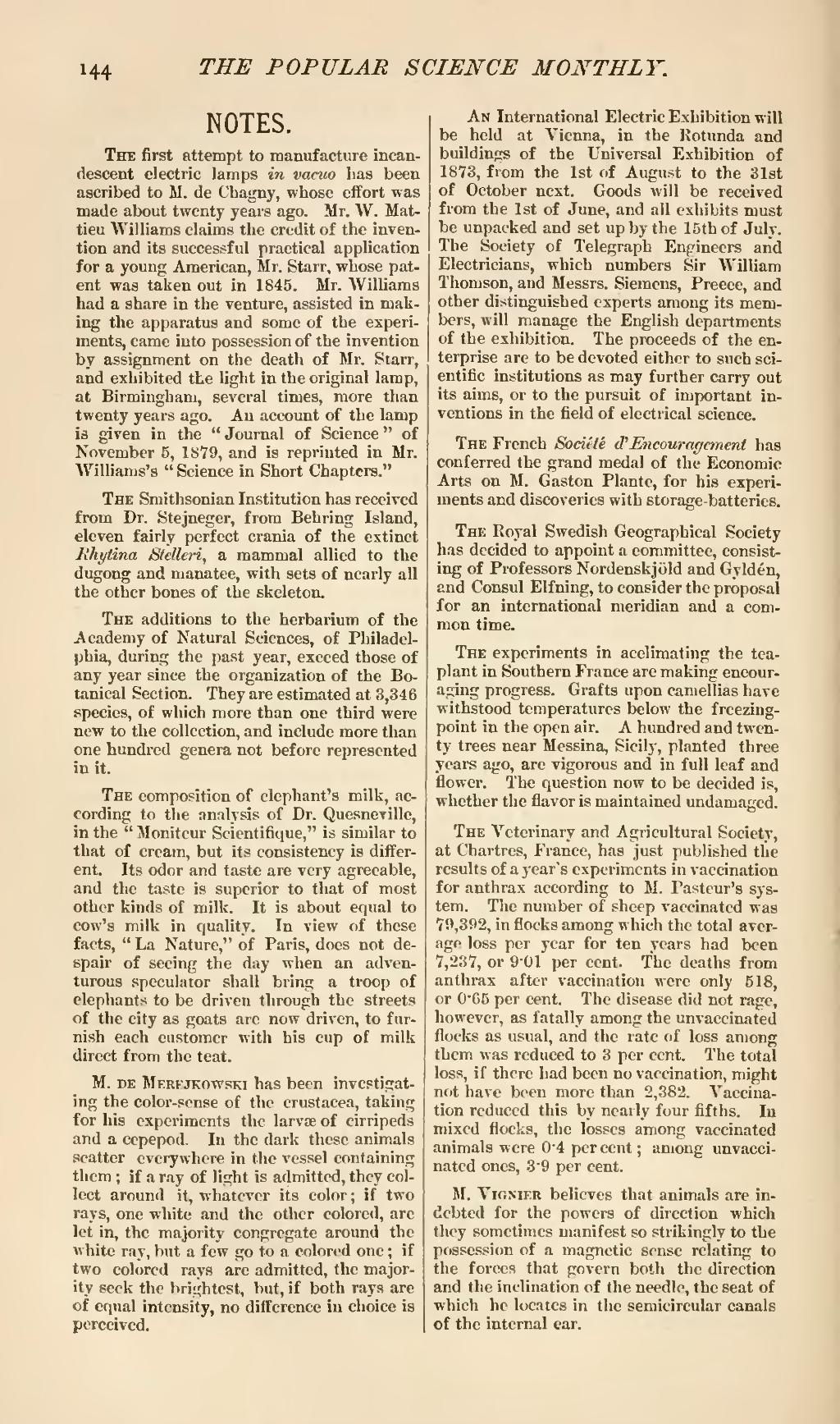The first attempt to manufacture incandescent electric lamps in vacuo has been ascribed to M. de Chagny, whose effort was made about twenty years ago. Mr. W. Mattieu Williams claims the credit of the invention and its successful practical application for a young American, Mr. Starr, whose patent was taken out in 1845. Mr. Williams had a share in the venture, assisted in making the apparatus and some of the experiments, came into possession of the invention by assignment on the death of Mr. Starr, and exhibited the light in the original lamp, at Birmingham, several times, more than twenty years ago. An account of the lamp is given in the "Journal of Science" of November 5, 1879, and is reprinted in Mr. Williams's "Science in Short Chapters."
The Smithsonian Institution has received from Dr. Stejneger, from Behring Island, eleven fairly perfect crania of the extinct Rhytina Stelleri, a mammal allied to the dugong and manatee, with sets of nearly all the other bones of the skeleton.
The additions to the herbarium of the Academy of Natural Sciences, of Philadelphia, during the past year, exceed those of any year since the organization of the Botanical Section. They are estimated at 3,346 species, of which more than one third were new to the collection, and include more than one hundred genera not before represented in it.
The composition of elephant's milk, according to the analysis of Dr. Quesneville, in the "Moniteur Scientifique," is similar to that of cream, but its consistency is different. Its odor and taste are very agreeable, and the taste is superior to that of most other kinds of milk. It is about equal to cow's milk in quality. In view of these facts, "La Nature," of Paris, does not despair of seeing the day when an adventurous speculator shall bring a troop of elephants to be driven through the streets of the city as goats are now driven, to furnish each customer with his cup of milk direct from the teat.
M. de Merejkowski has been investigating the color-sense of the crustacea, taking for his experiments the larvae of cirripeds and a cepepod. In the dark these animals scatter everywhere in the vessel containing them; if a ray of light is admitted, they collect around it, whatever its color; if two rays, one white and the other colored, are let in, the majority congregate around the white ray, but a few go to a colored one; if two colored rays are admitted, the majority seek the brightest, but, if both rays are of equal intensity, no difference in choice is perceived.
An International Electric Exhibition will be held at Vienna, in the Rotunda and buildings of the Universal Exhibition of 1873, from the 1st of August to the 31st of October next. Goods will be received from the 1st of June, and all exhibits must be unpacked and set up by the 15th of July. The Society of Telegraph Engineers and Electricians, which numbers Sir William Thomson, and Messrs. Siemens, Preece, and other distinguished experts among its members, will manage the English departments of the exhibition. The proceeds of the enterprise are to be devoted either to such scientific institutions as may further carry out its aims, or to the pursuit of important inventions in the field of electrical science.
The French Société d'Encouragement has conferred the grand medal of the Economic Arts on M. Gaston Plante, for his experiments and discoveries with storage-batteries.
The Royal Swedish Geographical Society has decided to appoint a committee, consisting of Professors Nordenskjöld and Gyldén, and Consul Elfning, to consider the proposal for an international meridian and a common time.
The experiments in acclimating the tea-plant in Southern France are making encouraging progress. Grafts upon camellias have withstood temperatures below the freezing-point in the open air. A hundred and twenty trees near Messina, Sicily, planted three years ago, are vigorous and in full leaf and flower. The question now to be decided is, whether the flavor is maintained undamaged.
The Veterinary and Agricultural Society, at Chartrcs, France, has just published the results of a year's experiments in vaccination for anthrax according to M. Pasteur's system. The number of sheep vaccinated was 79,392, in flocks among which the total average loss per year for ten years had been 7,237, or 9∙01 per cent. The deaths from anthrax after vaccination were only 518, or 0∙65 per cent. The disease did not rage, however, as fatally among the unvaccinated flocks as usual, and the rate of loss among them was reduced to 3 per cent. The total loss, if there had been no vaccination, might not have been more than 2,382. Vaccination reduced this by nearly four fifths. In mixed flocks, the losses among vaccinated animals were 0∙4 percent; among unvaccinated ones, 3·9 per cent.
M. Vignier believes that animals are indebted for the powers of direction which they sometimes manifest so strikingly to the possession of a magnetic sense relating to the forces that govern both the direction and the inclination of the needle, the seat of which he locates in the semicircular canals of the internal ear.
